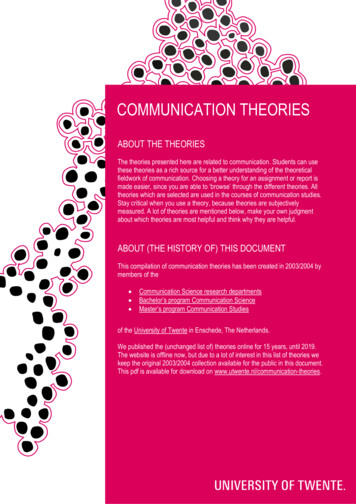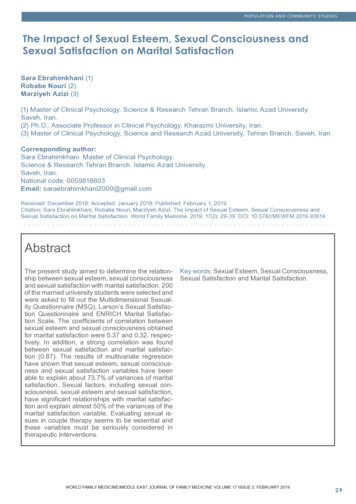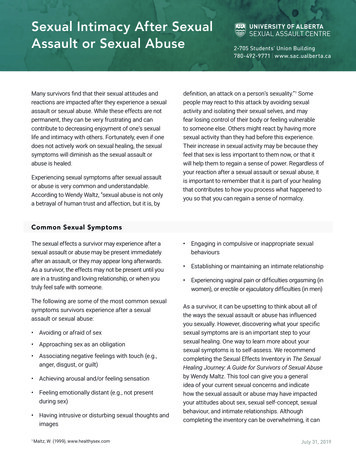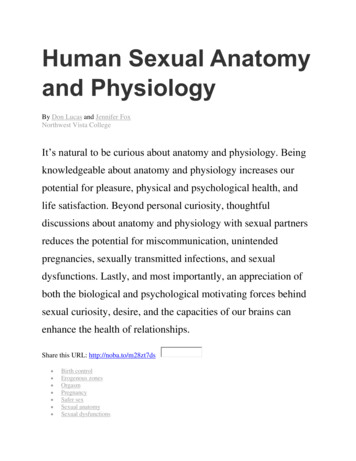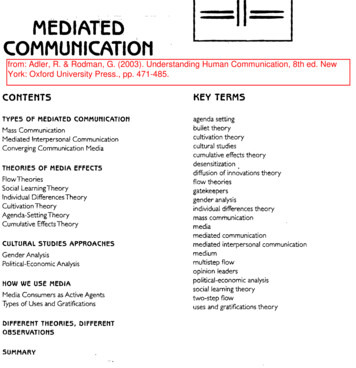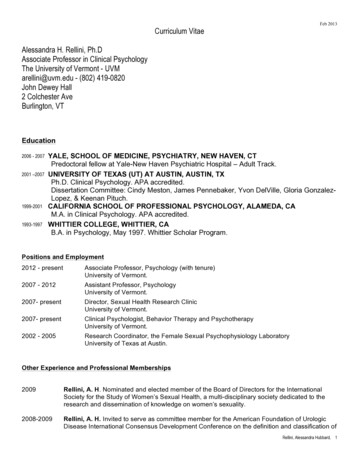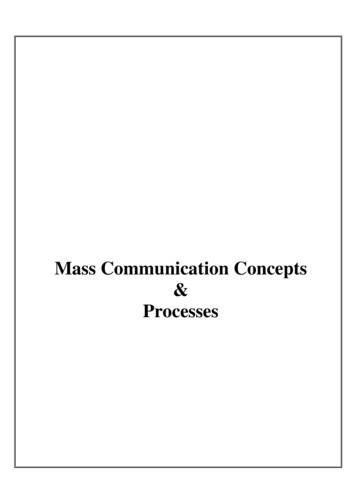
Transcription
THEORIES OF SEXUAL OFFENDINGGENERAL THEORIESThis article represented an attempt to integrate awidely disparate literature concerning factors thatplay a role in the etiology of sexual offending andlead to its persistence . In order to achieve their goal,the authors discuss biological influences, childhoodexperiences, general cultural features, availability ofpornography, and transitory situational factors . Inconclusion, the authors stated that all of these factors must be taken into account when planning thetreatment of sex offenders .& MARSHALL, WL . (1990) . A CONDITIONING THEORY OF THE ETIOLOGY AND MAINTELAWS, D .R .,NANCE OF DEVIANT SEXUAL PREFERENCE AND B EHAVIOR . I N W.L.MARSHALL (EDS .), HANDBOOK OFSEXUAL ASSAULT: ISSUES, THEORIES, AND TREATMENTOF THE OFFENDER, 13,209-229 .NEWYORK :PLENUM PRESS .This article presented a theoretical model of sexually deviant interests that described how they maybe learned through the same mechanisms by whichconventional sexuality is learned . The model isdivided into two parts : acquisition processes andmaintenance processes . The authors noted that themodel adopts the position that maladaptive behavior can result from quantitative and qualitativecombinations of processes that are themselvesintrinsically orderly, strictly determined, and normal in origin. This conditioning and social learningmodel stated that deviant sexual preferences andcognitions are acquired through the same mechanisms by which other persons learn more conventionally accepted modes of sexual expression . Themodel is presented as a set of 13 general principlesand 14 propositions that are derived from the 13principles. There are six basic conditioning ng, Extinction, Punishment, DifferentialConsequences, and the Chaining of Behavior) ; twosocial learning influences (General Social LearningInfluences and Self-Labeling Influences) ; and threemaintenance processes (Specific AutoeroticInfluences, Specific Social Learning Influences, andIntermittent Reinforcement) . In addition, theauthors discuss the treatment application of the theoretical model.SCHWARTZ,15, 257-275 .CHARACTERISTICSINB.ANDSCHWARTZ(EDS .) . THE SEX OFFENDER : CORRECTIONS, TREATMENT AND LEGAL PRACTICE,2.NEW JERSEY: CIVICRESEARCH INSTITUTE, INC .Outlined theoretical explanations for sexuallydeviant behavior, including : psychoanalytic theory,ego psychology theory, neurosis theory, Jungiantheory, relational theories, behavioral theories, cognitive-behavioral theories, addictions theory,anthropological theories, family theories, societaltheories, political theory, the integrated theory ofchild abuse, and the integrated theory of deviancy.Further, it reviewed causative factors and methodsof treatment .(1999) . CHILD MOLESTERS'IMPLICIT THEORIES . JOURNAL OF INTERPERSONALWARD, T., & KEENAN, T .VIOLENCE, 14 (8),821-838 .The authors argued that child molesters' cognitivedistortions are generated by maladaptive implicittheories concerning the nature of victims, theoffender, and the world . An examination of a number of scales used to measure distortions and severalarticles describing offenders' cognitive distortionsresulted in the formulation of five implicit theories-Children as Sexual Objects ; Entitlement ;Dangerous World ; Uncontrollability; and Nature ofHarm-each capable of generating a number ofmaladaptive thoughts . Implicit theories were usedto explain, understand, and predict the behavior ofvictims and aid in the planning and execution ofMARSHALL, W.L ., & BARBAREE, H.E . (1990). ANINTEGRATED THEORY OF THE ETIOLOGY OF SEXUALOFFENDING . IN W. L. MARSHALL (EDS .), HANDBOOKOF SEXUAL ASSAULT: ISSUES, THEORIES, AND TREATMENT OF THE OFFENDER,B.K. (1995) .TYPOLOGIES OF SEX O FFENDERS .NEW YORK :PLENUM PRESS .221
sexual offenses . They typically were not consciouslyarticulated and facilitated the processing of offenserelated information . According to the authors, therewas ample evidence from developmental, social,cognitive, and personality psychology to supportthe influential role of implicit theories in individuals' understanding of themselves and the socialworld . It is therefore reasonable to assume that themultitude of distorted beliefs and attitudes exhibited in child molesters are the product of a smallnumber of theories . The authors suggested thateffective treatment is likely to require the challenging and restructuring of these core theories . Finally,the authors argued that it is possible to develop anintegrated account of child molesters' cognitive distortions by focusing on the role of implicit theoriesin offense-related behavior. This perspective linkedresearch and theory in a number of diverse areas ofpsychology and attempted to create a commonframework for understanding the relationshipbetween cognition and behavior.abusive clerics . Hands argued that the experience ofshame interacts with unrealistic, moral expectationsthat have been internalized . The result of thisprocess is a shame cycle, which stunts the individual's psychosexual development and contributes tosexual misconduct . The internalization of Churchdoctrine concerning celibacy/chastity reinforcesmany cognitive distortions, which allow the cycle ofabuse to persist . The Church's interpretation of sexual misconduct as a personal sin directly contrastswith the view held by the criminal justice system .The Church has also discouraged the formation ofclose friendships among the clergy for fear that itmight lead to homosexuality. With increased socialisolation comes increased alienation from the body .Thus sexuality is repressed only to later emerge asan obsession . According to Sullivan, "primary genital phobia" is a result of this repression . When theindividual experiences any sexual feelings,thoughts, or emotions they are reflexively ignored .The obsession occurs because these feelings arenever directly addressed or managed in a productive manner.WARD, T., & HUDSON, S .M . (1998) . THE CONSTRUCTION AND DEVELOPMENT OF THEORY IN THE SEXUALOFFENDING AREA :SEXUALABUSE :A META-THEORETICALA JOURNALOFFRAMEWORK .RESEARCHJENKINS, P. (1996) .ANATOMYt YOFAPEDOPHILES AND PRIESTS :CONTEMPORARYTREATMENT, 10, 1 .BRIDGEWATER, NJ : REPLICA BOOKS.The authors outlined a meta-theoretical framework, or a multi-theory approach to sexual abuse,that took into account a number of different levelsof theory, such as comprehensive, middle, andmicro-levels, and stresses the importance of distinguishing between different types of causal factors .Further, the authors illustrated the utility of thedescribed meta-theory and demonstrated how different theories of sexual offending can be meaningfully integrated within this framework .CHAPTER 1 : THE CONSTRUCTION OFPROBLEMS AND PANICSThis chapter provided an overview of the format ofthe book and the issue of child sexual abuse in theChurch . While it has been acknowledged that theabuse occurs, Jenkins contends that not much else isknown about this issue . The author summarized theconstruction of the problem as going through thefollowing stages : (1) many clergy are active in thesexual abuse of children ; (2) many Catholic priestsare active in sexual abuse ; and (3) the structure ofCatholicism makes priests more likely to abuse children . The Catholic Church is likely to be targeteddue to its size and centralized hierarchy. Themedia's interpretation of cases of sexual abuse andlitigation make it impossible to compare the prevalence of abuse across denominations .THEORIES OF OFFENDING BY CLERGYHANDS,D .R .(2002) . BEYOND THE CLOISTER-SHAMED SEXUALITY IN THE FORMATION OF THE SEXOFFENDINGCLERGY. INB .K . SCHWARTZ &CELLINI (EDS .), THE SEX OFFENDER(Pp.CRISIS .H .R .29-1-29-8) .KINGSTON, NJ : CIVIC RESEARCH INSTITUTE .CHAPTER 2 : THE ANTI-CATHOLIC TRADITIONThis chapter presented a brief overview of the influence that Church doctrine has had on sexuallyIn this chapter, Jenkins provided a historicaloverview of anti-clericalism and anti-Catholicism .While it is believed that anti-Catholicism ceased222
during the 1930s to 1980s, Jenkins argued that theemergence of books such as Lead Us Not intoTemptation and A Gospel of Shame facilitated theseideas . Anti-Catholicism has also been integratedinto culture through development of Catholicstereotypes and humor. It is argued that the idea ofthe predatory priest has always existed in a subcultural setting only to emerge into mainstream culturewhen the time was right .to emerge and each had their own agenda . Sincethese cases were widely publicized, public awarenessof the issue of child sexual abuse also increased .Jenkins posits that these reports facilitated the investigation and prosecution of new cases as well as thecreation of the image of the pedophile priest .CHAPTER 5 : PEDOPHILIA AND CHILD ABUSEThis chapter sought to evaluate three specific areasof child sexual abuse by clergy : defining the abusein question, assessing the number of perpetrators,and establishing a historical context in which theallegations were made . In defining the problem,Jenkins drew attention to the differences betweenpedophilia and ephebophilia . While there werecases that involve extensive abuse, not all of themwere severe . The media's reliance upon the image ofthe pedophile priest thus distorted the true natureof the problem. In citing a study conducted by theChicago Diocese, Jenkins ascertained that theprevalence rate amongst priests is less than two percent . In establishing an historical context, theauthor illustrated how social feelings concerningsex offenders have cycled through the years . Duringthe 1980's the effects of abuse on the victims beganto receive attention that raised public awarenessconcerning sex offenders . The McMartin abusescandal influenced ideas about clergy abuse by illustrating that sexual abuse could occur anywhere,leading to heightened suspicion . A discussion concerning the treatment of clergy offenders isincluded . Due to the dwindling number of priests inthe seminary, the Church was willing to shift attention away from punitive measures to treatmentneeds in order to preserve its numbers . Treatmentprograms were created in the belief that theoffender could be cured and reinstated into the ministry. While experts in the field attacked this pointof view, it was still followed by the Church .CHAPTER 3 : THE DISCOVERY OF CLERGY SEX ABUSEJenkins claimed that during the 1980's, allegationsof sexual abuse committed by priests became prevalent . Two views about this phenomenon exist . Oneargument theorized that the abuse has been aroundfor years but that it has only emerged during thelast decade . Accepting this argument would meanthat the crisis began in the 1960's, perhaps as aresult of relaxed sexual discipline . The second argument posited that the abuse is a result of the liberalreforms of Vatican-II . Jenkins provided anoverview of the publicized cases and included atimeline of major events . He hypothesized that themajor scandal in the Louisiana diocese created a"snowball effect" in which the media increased theircoverage of the issue and became more aggressive inpursuing such stories . This placed pressure upon theChurch, which had to react quickly by implementingnew policies in order to handle the problem . As aresult of the media portraying the abuse as "aCatholic problem," they have neglected to evaluatethe prevalence of abuse . in other denominations .CHAPTER 4 : THE MEDIA AND THE CRISISThis chapter discussed the media coverage of sexualabuse in the Catholic Church in both national andlocal publications . These publications portrayed theproblem as being a crisis and scandal, requiringswift intervention . The news media also utilizedimages unique to the Catholic Church, which further characterized the crisis as being solely aCatholic phenomenon . Jenkins drew a contrastbetween these images and . the more wholesome portrayal of the Catholic Church in films madebetween 1938 and 1944 . Changing media valuesare one possible reason for this occurrence as theemphasis shifted towards tabloid reporting and sensationalism . In constructing the abuse "crisis," themedia turned to Jason Berry and Andrew Greeley asexperts . Soon, other authorities on the topic beganCHAPTER 6 : CONFLICT IN THE CHURCHESIn evaluating the cases of sexual abuse in theChurch, various themes began to emerge . Jenkinsasserted that "the authoritarian nature of theChurch and its hierarchy, the special privilegesaccorded to priests, the apparent neglect of theinterests of women and children, and an ambiguousand hypocritical attitude towards sexuality" arenotions that have existed for years . This battlebetween liberals and conservatives in the Church22 3
was sparked by the reforms of Vatican-II and adwindling priesthood . Church doctrine concerningsexuality came under fire from Catholic traditionalists who felt that the reforms of Vatican-II were tooliberal and facilitated an environment in whichabuse was allowed to exist . The liberals were concerned about reforms to the patriarchal Churchhierarchy, which displayed little consideration forthe laity. The clergy abuse scandal provided a platform for reformists to point out the apparent hypocritical nature of various Church doctrines .CHAPTER 9 : DEFENDING THERAPYJenkins posits that mental health professionals alsohave an interest in clergy litigation, as they wouldbe called for treatment and their expert opinion . Asthe definition of child abuse changed in the 1970's,children were viewed as honest witnesses . This wasimpacted by a variety of research that evaluated thechild's capability as a witness and the validity ofmemories . During the 1980's, allegations of ritualsexual abuse swept the nation and created a modern day witch-hunt . This chapter included a briefoverview of the recovered memory phenomenon,media attention allotted the topic, and its impact onallegations of sexual abuse . Clergy abuse served toreinforce therapeutic assumptions whereas the ideasconcerning ritual abuse reinforce the idea of thepedophile priest . As the validity of recovered memories and ritual abuse allegations were exposed, abacklash occurred where the topic lost any momentum it may have had .CHAPTER 7 : "SINS OF THE FATHERS" ;THE FEMINIST RESPONSEThis chapter discussed the role of the feminist movement in the exposure of sexual abuse in the generalpopulation and clergy. Church doctrine concerningabortion and birth control came under criticism as aresult of the movement . Feminists argued that sexualviolence is a result of patriarchal culture, which isinfluenced by social institutions such as the CatholicChurch. When the allegations of abuse began toemerge, feminists integrated them as evidence in favorof their argument . The definition of clergy sexualabuse was broadened to incorporate heterosexualrelations between the priest and adult women .Jenkins argued that feminist rhetoric benefited from asocial environment already ripe with discontent andan ever-changing legal interpretation of the problem .JENKINS, P.(1998) .CREATING A CULTURE OF CLERGYD EVIANCE . IN A. SHUPE (ED .) WOLVES WITHIN THEFOLD : RELIGIOUS LEADERSHIP AND ABUSES OF POWER(pp. 118-132) .NEWBRUNSWICK,NJ:RUTGERSUNIVERSITY PRESS .Clergy deviance is explained through the impact themedia has had in publicizing "scandals" and thereactions of Catholics to this news . Jenkins assertedthat there were no scandals prior to the 1970's . Thismeant that the Church was protected from mediascrutiny and that the pattern of multiple offensescommitted by "pedophile priests" could not be followed . The media blackout promoted an environment in which those few priests who were inclinedto engage in malfeasance experienced a sense ofinvulnerability because there was no possibility ofincurring sanctions . The internal structure df theChurch and the shortage of priests caused manyBishops to ignore discrepancies in order to preservethe clergy. Jenkins provided an overview of therelationship between the Catholic Church andmedia dating back to the 1920's . In the media's zealto expose scandals in the Catholic Church, theChurch utilized its power to boycott such publications . This ploy proved effective in controllingpotential scandals . During the 1970's, films andnovels depicted the secret sexual lives of priests,which is in stark contrast to the wholesome films ofthe 1950's . Jenkins posits that the Watergate scandalCHAPTER 8 : THE LEGAL ENVIRONMENTDuring the 1980's the civil system saw the growth oftorts concerning child sexual abuse . This was due tothe claims of child maltreatment in nursery schoolsacross the nation as well as new research concerningthe credibility of child witnesses and recovered memories . This was also the first time that mandatorychild abuse reporting statutes were passed throughout the nation. The Church is a billion-dollar industry, which makes it an appealing target for civil litigants . Litigation was pursued even when theevidence was not very strong and based upon retrospective data . Due to the statute of limitations, criminal prosecution was not an option for many victims .When the Church tried to defend itself against theseexcessive civil suits, various organizations claimedthat hypocrisy and selfishness were inherent in theChurch hierarchy . Jenkins argued that juries aremore likely to be sympathetic towards victims,thereby creating an environment in which clergylitigation is an appealing choice .224
played a role in encouraging expose journalism . Thiscoupled with changing demographics and a split inthe Church concerning the revisions of Vatican II, allplayed a role in creating an environment in whichsexual abuse scandals were exposed by the media .According to Jenkins, "Media attitudes thereforehelped create an absolute criminogenic social environment," and the extent to which this environmenthas been exploited remains unclear .institutions . The reason why sexual abuse in theChurch is a major issue is because the offenders areordained priests who took a vow of celibacy .LOFFUS, J .A . (1999) . SEXUALITY IN PRIESTHOOD : NoLIME TANGERE. IN T.G . PLANTE (ED .) BLESS ME FATHERFOR I HAVE SINNED : PERSPECTIVES ON SEXUAL ABUSECOMMITTED BY ROMAN CATHOLIC PRIESTS (pp. 7-19) .WESTPORT, CT: PRAEGER PUBLISHERS .KREBS, T. (1998) . CHURCH STRUCTURES THAT FACILITATE PEDOPHILIA AMONG ROMAN CATHOLIC CLERGY.I N A . SHUPE (ED .) WOLVES WITHIN THE FOLD:RELIGIOUS LEADERSHIP AND ABUSES OF POWER(pp. 67-84) . NEW BRUNSWICK, NJ : RUTGERSUNIVERSITY PRESS.Loftus provided an historical overview of sexuality inthe priesthood . He explained that a focus of priestlyteachings concerning celibacy is characterized by thephrase "if no one touches me, I will not experiencesexual desire, or at least not sexual temptation ." Thework of Sipe is discussed in examining the issue ofcelibacy. The author contends that there is no simpleway to define celibacy and that it is a complex anddynamic issue . There is also a public relations issuerelated to the fact that many parishioners believe thatpriests are indeed celibate and always have been . Thework of Loftus & Camargo (1993) is discussed andthe author posits that the question should not bewhat an acceptable definition of celibacy is, butrather how sexuality is experienced within this population . Research is hindered because there is noaccess to data concerning sexuality in the "normal"priest population .Krebs argued that the structure of the Church and itshierarchy facilitate sexual abuse . Anonymity wasgranted to pedophiliac priests due to the Church'sinternational nature, organizational hierarchy, andinternal polity. The organizational hierarchy was discussed in relation to the work of Andrew Shupe, whoobserved five unique characteristics . Institutionalreligion is based on what Shupe called "hierarchies ofunequal power," which span different dimensionsincluding the spiritual and organizational . Those inelite positions have moral authority, which allowsthem to control privileges as well as shun and excommunicate . Third, the Catholic Church is what Shupereferred to as a "trusted hierarchy," which influencedparental socialization of children to believe and trustin Church officials . Clergy malfeasance occurs intrusted hierarchies . Fourth, the structure of theChurch provided "opportunity structure" and "protected places" that allow for deviancy . The Churchalso engaged in neutralization to protect theseoffending priests . In turn, this gives the pedophileapproval from superiors to continue offending .Shupe contends that by taking any neutralizingaction, the problem can occur once more . Thesepriests can be reassigned to new parishes and diocesewhere only a few members of the hierarchy mayknow their history . Krebs also argued that newlyimplemented structures continued to facilitatepedophilia in the Church . One such structure is thestudy group comprised of the entire Church community, which seeks to find a solution to this problem .Krebs asserted that the focus of these groups hasbeen to ascertain that while sexual abuse occurs inthe Catholic Church, it is more prevalent in otherLoTHSTEIN, L . (1999) . NEUROPSYCHOLOGICAL FINDINGS IN CLERGY WHO SEXUALLY ABUSE. I N T.G. PLANFE(ED .) BLESS ME FATHER FOR I HAVE SINNED :PERSPECTIVES ON SEXUAL ABUSE COMMITTED BYROMAN CATHOLIC PRIESTS (pp. 59-85) . WESTPORT,CT: PRAEGER PUBLISHERS .This chapter presented a review of the literature concerning neuropsychology and sexual offending .Studies have shown that there appear to be abnormalities located in the fronto-temporal region of thebrain of sex offenders . However, these studies sufferfrom methodological flaws and the results are typically confounded by substance abuse . The Institutefor Living clergy study is discussed, in which 400clerics have been evaluated for paraphiliac and nonparaphiliac sexual behavior . The findings supportedthe theory that sex offenders, from the general andcleric population, appear to have an abnormality inthe fronto-temporal region of their brains . While theabnormalities are similar there are differencesbetween the cleric and non-cleric offenders . The225
author warned against inferring a causal linkbetween brain dysfunction and paraphiliac behavior .It was recommended when assessing clerics thatthose who have a history of hard neurological signs(massive head trauma, seizures, history of unconsciousness, etc .) should be considered as being at ahigh risk for sexual disinhibition . Those who have ahistory of soft neurological signs (impulsivity, anxiety, etc.) must also be thoroughly evaluated .PALLONE,BETRAYAL:NJ .(2002) .SIN,A PSYCHODYNAMICCRIME,The author presented a response to the theories proposed by the Winter Commission in Newfoundland .In posing this argument, it was urged that theChurch look even deeper into the institutional andstructural roots of sexual abuse within institutions .According to ethnographic data, sexual abuse is notendemic or universal . Scheper-Hughes argued that"social isolation, arbitrary parental authority overchildren, patriarchal values, single-parent households, and negative images of the social worth ofchildren all promote and exacerbate child sexualabuse." A brief discussion concerning clergy abuse inIreland is included . The author cited the work ofKennedy (1972) who found that 8% of priests weremaldeveloped, 57% were underdeveloped, 29%were developing, and only 6% were developed . In apersonal interview with the author he ascertainedthat "The vows of poverty and obedience infantalizethe adult male, making him dependant on a series offather figures at a time when they should be in control of their own lives and responsible for the lives ofchildren and young people . The vow of celibacytakes from the adult a main vehicle for the expressionof intimate social relations . The end result is chronicinfantilization ." However, the Winter Commissionwas silent on the topic of celibacy . The author drawsparallels between corporal punishment, with itserotic undertones, to that of clergy abuse . Corporalpunishment was said to have created a sexualizedenvironment, which may have provided theantecedent conditions for sexual offending .ARROGANCE,PERSPECTIVE ON THE CRI-SIS IN AMERICAN CATHOLICISM . BRIEF TREATMENTAND CRISIS INTERVENTION, 2 (4), 341-372 .In this article Pallone states that the crisis of sexualmisconduct in the Roman Catholic Church is in facthomosexual statutory rape . Along this line, Pallonealso states that a majority of the victims were not of"pre-pubescent age" as specified in the DSM IV;therefore the offenders cannot be consideredpedophiles . It is a new disorder, considered ephebophilia, and he presents an in-depth explanation of thedisorder based on "Fenichel's (1945) speculationsabout the genesis of psychosexual pathology among(sexually inexperienced but palpably) narcissistic adultmales and incorporating the contribution of Catholicdoctrine on the Virgin birth" (p . 366) . The disorder isnot yet recognized by the DSM IV; however, there is adanger in creating a new category of mental disorderwhose behavior has been deemed criminal .The offenders consist of a relatively small number ofpriests . Few clerics were being prosecuted, and onlyseemed to face arrest and prosecution after the presshad learned of the civil liability payments made tothe victims . In most situations, responsibility is notadmitted by the diocese, while the victims are paid tokeep silent . The press focuses only on current caseswhile those that occurred more than a month ago isconsidered ancient history . Pallone points out thatthis is not an isolated American phenomenon, but isalso occurring in countries such as Ireland, Canada,Australia, England, Poland, and Africa .SIPE, A.WR. (1995) .ANATOMY OF A CRISIS, 1, 3-23, NEW YORK,N.Sipe extrapolated upon the findings of his 1990book, A Secret World : Sexuality and the Search forCelibacy . In studying the celibacy patterns ofCatholic priests, the author postulated that 20%have engaged in heterosexual relationships andbehaviors, 10% have engaged in homosexual behavior, 4% have had adolescent partners and 2% arepedophiles . Sipe asserted that child molestation is aresult of the flawed celibate/sexual system of theChurch . Since the Church has not developed a clearunderstanding of human sexuality in general, theywere unable to formulate a response to this issue .This is coupled with the fact that the teachings of theChurch were not always followed by those in power.SCHEPER-HUGHES & C . SARGENT (EDS .) SMALL WARS : THE CUL-TURAL POLITICS OF CHILDHOOD (PP .BERKELEY,CA: UNIVERSITYNY:BRUNNER/MAZEL, INC .SCHEPER-HUGHES, N . (1998) . INSTITUTIONALIZED SEXABUSE AND THE CATHOLIC CHURCH . INSEX, PRIESTS, AND POWER :295-317) .OF CALIFORNIA PRESS .226
After having reviewed the histories of 473 abusivepriests, it was found that 70-80% of priests were sexually abused as children and 10% were approachedby a priest while studying in the seminary. Theauthor has developed four specific categories toexplain sexual abuse in the clergy. Those in Sipes'Genetic Lock find that their sexual attraction isinherently determined . The Psychodynamic Lockconsists of priests who, as a result of their childhoodexperiences, have been locked into one level of psychosexual development, rendering them prone tooffending behavior. Sipe hypothesized that a combination of genetic and psychodynamic factors interacts with cognitive factors . All of these variablescombine in such a manner as to influence the priestto sexually abuse a child. In the Social/SituationalLock, the priest is otherwise healthy but the experience of celibacy suspends their psychosexual development . Similar to the theory of primary genital phobia,sex is externally denied but internally explored. Sipeconcluded that the offending behavior is of a developmental nature, which could be resolved, once theoffender matured . The Moral Lock provided no clearexplanation for the offending behavior . According toSipe, these individuals are cold and calculating andmake a conscience choice to sexually abuse childrenjust because they desire the experience .SIPE, A .WR. (1995) .be resolved through confession and penance . Duringthe course of treatment, the Church should monitorthe offender for a period of about five years .SIPE,.R.WA (1998) . CLERGY ABUSE IN IRELAND . IN A.SHUPE (ED .) WOLVES WITHIN THE FOLD : RELIGIOUSLEADERSHIP AND ABUSES OF POWER (PP. 133-151) .NEW BRUNSWICK, NJ : RUTGERS UNIVERSITY PRESS .This chapter provided an overview of clergy abuse inIreland. What made the abuse in Ireland so unique isthe integration of Church and State, which hasexisted since the country's emancipation from theUK . Through the years, various reforms haveoccurred including the legalization of divorce and theAbortion Information Bill, which allowed certainmedical centers to provide information pertaining tothe operation . These reforms did not occur until themid-1990s . In 1996, the Irish hierarchy pledged fullcooperation with the authorities in addressing theissue of cleric abuse . Sipe contends that all of theaccounts of sexual abuse in Ireland have in fact beenwell known and recorded accurately albeit censored .This abuse has been known as a characteristic of theChurch in Ireland for years . The relation between theIrish Church and that of the American Church illustrated an interesting connection in supporting Sipe'sthesis . Seventeen percent of the US population duringthe period of 1960-1970 was Irish American .However, 54% of priests were Irish Americans orIrish and 85% of archbishops and 75% of Bishopswere Irish American . This connection has led Sipe toraise the following questions : (1) Is there a correlation between ethnic origin and clergy abuse ; (2)What is the rate of sexual abuse/activity by priests inIreland versus the US ; (3) How many sexually abusive priests in the US, England, and elsewhere wereborn or educated in Ireland; (4) Is the proportion ofknown sexua
model adopts the position that maladaptive behav-ior can result from quantitative and qualitative combinations of processes that are themselves intrinsically orderly, strictly determined, and nor-mal in origin. This conditioning and social learning model stated that deviant sexual preferences and cognitions are acquired through the same mecha-

